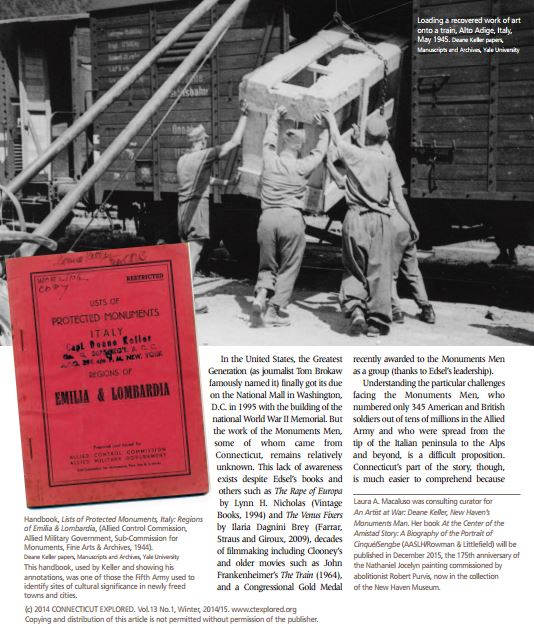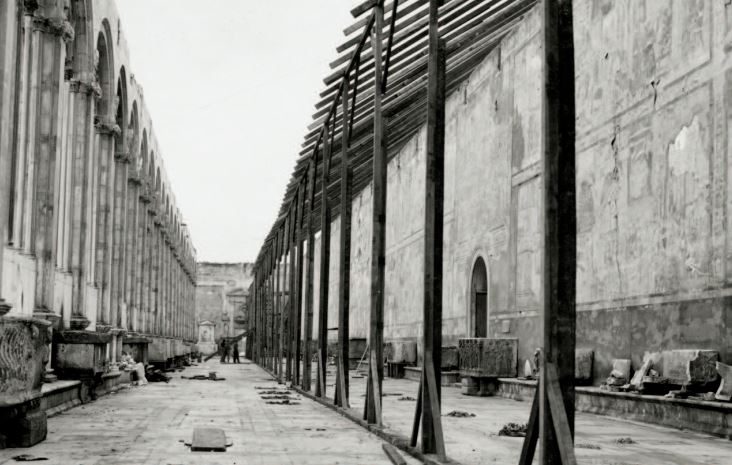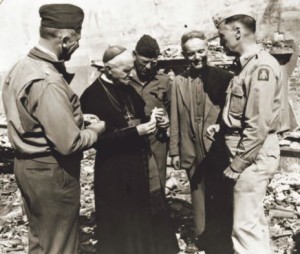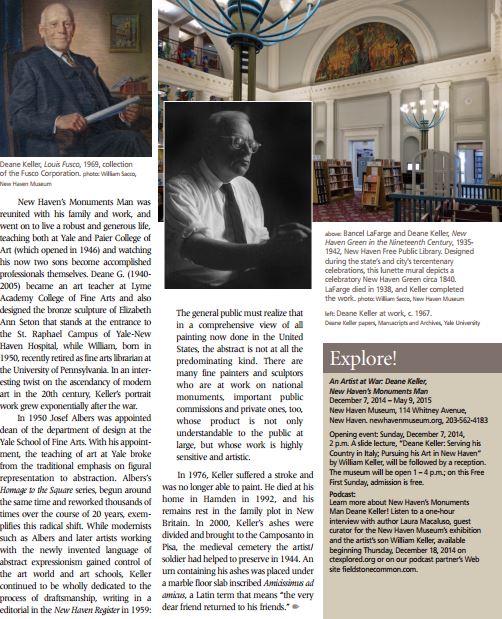By Laura A. Macaluso
(c) Connecticut Explored Inc. WINTER 2014/15
Subscribe/Buy the Issue!
“In wartime, when the thoughts of men fighting nations are concerned primarily with winning battles and the consequent fear, animosity, hatred, blood and death, it seems incongruous and inconsistent that the commanders of opposing armies should give attention to culture and Fine Arts. Yet in both the Nazi-Fascist and Allied Armies, perhaps for the first time in history, there were men whose sole job it was to preserve the heritage and culture of nations being torn to shreds by the ravages of war. Italy was the first to know the men whose job it was to care for her cultural and artistic heritage in wartime.”
Robert Edsel begins his 2013 book Saving Italy, The Race to Rescue a Nation’s Treasures from the Nazis (W.W. Norton & Company) with this passage written by New Haven’s Deane Keller, an army captain (later major) who left his wife, a young son, and a full-time position teaching art at Yale University in 1943 to volunteer for the Allied cause at age 42. Thanks to George Clooney’s recent film The Monuments Men (Sony, 2014), a story built on Edsel’s research including his 2009 book of the same title, the general public now has some awareness of what had been a neglected sideline to the history of bombs, battles, and, above all, the horrors of the Holocaust.
During the Second World War, for the first time in history, soldiers were involved in the preservation of cultural heritage; this was not only of concern to the Allies, but also to the Axis. Everyone, it seems, understood the value of cultural heritage for political, psychological, and propagandistic purposes. A veritable race to control heritage—by stealing it, displaying it, or destroying it—was underway by the time the Monuments Men set foot in southern Italy. The Monuments Men worked to thwart the efforts of the Nazis and the Fascists, and their success rate was high. An exhibition about Keller, one of the most important Monuments Men serving in Italy, is on view at the New Haven Museum from December 7, 2014 through May 9, 2015. (See Explore!, page 31.)
In the United States, the Greatest Generation (as journalist Tom Brokaw famously named it) finally got its due on the National Mall in Washington, D.C. in 1995 with the building of the national World WarII Memorial. But the work of the Monuments Men, some of whom came from Connecticut, remains relatively unknown. This lack of awareness exists despite Edsel’s books and others such as The Rape of Europa by Lynn H. Nicholas (Vintage Books, 1994) and The Venus Fixers by Ilaria Dagnini Brey (Farrar, Straus and Giroux, 2009), decades of filmmaking including Clooney’s and older movies such as John Frankenheimer’s The Train (1964), and a Congressional Gold Medal recently awarded to the Monuments Men as a group (thanks to Edsel’s leadership).
Understanding the particular challenges facing the Monuments Men, who numbered only 345 American and British soldiers out of tens of millions in the Allied Army and who were spread from the tip of the Italian peninsula to the Alps and beyond, is a difficult proposition. Connecticut’s part of the story, though, is much easier to comprehend because Deane Keller left copious documentation of his life and work. Born in New Haven in 1901, Keller was a dedicated teacher, soldier, husband, and father. His papers, which the Keller family donated to the Yale University Library, are valuable for their detailed documentation of the work the Monuments Men did in Italy. The papers also reveal the work of an artist who returned home to Yale and New Haven to find that the war had hastened a startling shift in art, directly affecting his professional career.
Except for two substantial periods in Italy and summers in Maine, Deane Keller spent his life in New Haven and Hamden, working and raising his family. Though he is associated primarily with Yale—his teaching career there spanned 40 years—his production of portraits, a trade in which he excelled, took him far beyond the cloistered courtyards of the university. Everyone from Yale faculty to politicians and legislators to industry leaders commissioned his work. The Elm City is filled with Keller paintings: 37 of his portraits are in the collection of the Yale University Art Gallery, and others are on view around campus and throughout the city, in places as diverse as City Hall, the headquarters of the Knights of Columbus and the FUSCO Corporation, the Quinnipiack Club, the New Haven Museum, and the St. Raphael Campus of Yale-New Haven Hospital. Beyond New Haven, Keller’s portraits reside in collections as far away as Michigan, North Carolina, Hawaii, Chile, London, and Rome. All told, Keller painted about 500 portraits, creating a visual representation of the history of his era. An Artist at War: Deane Keller, New Haven’s Monuments Man offers an opportunity to learn about this remarkable man.
THE YOUNG ARTIST
Keller was the son of sociologist Albert Galloway Keller, a well-known professor at Yale with a formidable presence. Keller grew up on Huntington Street and attended Worthington Hooker School; surprisingly, given hislater career, he often received “fair” marks in drawing and “excellent” marks in science, according to the report cards he saved among his papers. When Keller reached college, his father pushed hisson to earn a history and science degree.
Keller graduated from Yale in 1923 with the degree that pleased his father, a B.A. in history and science. But Keller aspired to be a painter, and against his father’s wishes he took classes at the Art Students League in New York and then returned to Yale, where he earned a B.F.A. three years later. He was awarded the Prix de Rome fellowship at the American Academy in Rome the following year, which enabled him to travel and study in Italy for three years. He travelled the length of the country, learned the language, and reinforced his education in the foundational elements of drawing that lay at the heart of Italian Renaissance art. Keller thus began a life-long relationship with Italy and its people, and his experience gave him a skill set that would prove invaluable during war time.

Camposanto in Pisa with roof under construction, c. 1944. Deane Keller papers, Manuscripts and Archives, Yale University Upon seeing the level of destruction of the Camposanto (a sacred cemetery in Pisa with famous Renaissance frescoes), Keller called for assistance. Under his direction, army engineers and Italian military personnel built a temporary roof to protect what remained. Conservation and restoration of the frescoes continues today
After completing the fellowship, Keller took a full-time teaching position at Yale and met and married Katherine P. Hall, a student in his life drawing class. In the years before the United States entered World War II, Keller taught and launched his portrait business. He also painted one of the city’s most recognized works of public art: “The New Haven Green in the Nineteenth Century,” a lunette mural that accompanies Bancel LaFarge’s “The Personification of New Haven” in the main room of the New Haven Free Public Library. These murals were commissioned in 1934 under the Federal Art Project (FAP) of the Works Progress Administration (WPA), whose regional headquarters was located in New Haven. The first and most important director of the FAP/WPA in New Haven was Theodore “Tubby” Sizer, then associate director of the Yale University Art Gallery, who would also become one of the Monuments Men. Sizer called on Keller to finish the library commission when LaFarge died in 1938. Keller also supervised the painting of another WPA mural cycle in his old school, Worthington Hooker, but those murals do not survive.
TO WAR
In 1943 Keller was 42 years old and living with Katherine and their young son Deane G. Keller on Armory Street when he volunteered for active service. He was assigned to the Fifth Army, Manuscripts, Fine Arts & Archives (MFAA) Section, a unit informally called the “Monuments Men” (although a few women did serve in this capacity, too). Keller was stationed in Italy due to his ease with the language, culture, and geography. The purpose of the Fifth Army, a consortium of soldiers from Allied countries, was to both wrest control of Italy from Nazi Germany and restart society by re-opening banks, schools, and universities, clearing the landscape of mines, supporting the Red Cross, and helping to eradicate disease. Keller initially spent months in North Africa with the Fifth Army, waiting for deployment and taking classes in Italian that he described in a letter home as “pretty elementary,” as he was already close to fluency. In December 1943, Keller wrote to his family “I am so anxious for the next phase to begin but it’s in the hands of the Gods and no one knows.”
Keller’s copious correspondence with family and friends, along with newspaper clippings, guidebooks and monuments lists, photographs, and other such documents together trace the progress of war, from southern Italy into the northern city-states of Tuscany—the birthplace of the Italian Renaissance—and track the MFAA’s work, often conducted in tandem with soldiers on the front lines of battle, to identify and preserve a landscape filled with monuments, museums, archives, and archaeological sites.
Keller’s three years in the Fifth Army (1943-1946), in which he estimated he “billeted” (slept) in at least 130 places and drove more than 60,000 miles, were filled with points high and low. Moving through the rugged Italian terrain, often only with his photographer assistant Charlie Bernholz and their trusty jeep, of which Keller wrote, “I need it, for it is my life & my job,” Keller followed a basic set of actions or “Steps to Protect Art” that included mounting a guard and hanging “Do Not Enter” signs, seeking the aid of civilian personnel having knowledge of local heritage, hunting out records, checking objects and places for damage, and making an inventory. He learned this protocol from experience on the ground, but, as he was to discover, these strategies sometimes fell short of what the situation at hand required.
The two cities where Keller’s efforts had the most impact were the embodiment of the Italian Renaissance itself: picturesque Pisa and elegant Florence. In Pisa, Keller arrived with the advancing Allied army as the Nazisretreated, both sides bombing the historic city center to gain control and together damaging more than 80 percent of the city. Realizing that the most sacred area of the historic core of Pisa had been harmed, specifically the Camposanto—a cloistered cemetery with 14th- and 15thcentury frescoes—Keller directed civilians and soldiersin erecting a temporary roof of canvas supported by mahogany struts to protect the newly exposed walls and thousands of pieces of fresco lying on the ground. Their work was treacherous: Lead used in the original roof had melted over walls and sepulchers, and water was nowhere to be found, since German soldiers had taken all fire-fighting equipment with them. In 1946, near the end of his military tenure, Keller wrote to Katherine about his time in Pisa:
How does one feel when the bombs are crashing all around? I PRAYED I tell you and I was trembling like a damned leaf and once it lasted 1.5 hours and I thought of you and Deane and our life and what this all was. The window panes were rattling and some fell out. And in Pisa when the .240s were flying over every night at 8.15 or 10.15 or 12.15. We had that to look forward to every night.

(left to right) Major Hamilton T. Walker, Archbishop Gabriele Vettori of Pisa, Captain Deane Keller, Professor [first name unknown]Vincenzo, and Brigadier General Edgar Hume examining fragments in the ruins of the Camposanto, Pisa, c. September 1944. Deane Keller papers, Manuscripts and Archives, Yale University
HOME AGAIN
When Keller entered the military as captain he was already older, more experienced, and better educated than most others around him. After his efforts at Pisa where the Italians awarded him a medal, he was supposed to become a major. But the U.S. military sat on his paperwork, and he was not made a major until March 1946—14 months after his work in Pisa. By then all of the other Monuments Men had left Italy. He finally left for home in May. The experience devastated him, and he wrote about it in many letters: In one, the artist/soldier said it “has hurt me deeply and I shall never get over it.”
New Haven’s Monuments Man was reunited with his family and work, and went on to live a robust and generous life, teaching both at Yale and Paier College of Art (which opened in 1946) and watching his now two sons become accomplished professionals themselves. Deane G. (1940- 2005) became an art teacher at Lyme Academy College of Fine Arts and also designed the bronze sculpture of Elizabeth Ann Seton that stands at the entrance to the St. Raphael Campus of Yale-New Haven Hospital, while William, born in 1950,recently retired as fine arts librarian at the University of Pennsylvania. In an interesting twist on the ascendancy of modern art in the 20th century, Keller’s portrait work grew exponentially after the war.
 In 1950 Josef Albers was appointed dean of the department of design at the Yale School of Fine Arts. With his appointment, the teaching of art at Yale broke from the traditional emphasis on figural representation to abstraction. Albers’s “Homage to the Square” series, begun around the same time and reworked thousands of times over the course of 20 years, exemplifies this radical shift. While modernists such as Albers and later artists working with the newly invented language of abstract expressionism gained control of the art world and art schools, Keller continued to be wholly dedicated to the process of draftsmanship, writing in a editorial in the New Haven Register in 1959:
In 1950 Josef Albers was appointed dean of the department of design at the Yale School of Fine Arts. With his appointment, the teaching of art at Yale broke from the traditional emphasis on figural representation to abstraction. Albers’s “Homage to the Square” series, begun around the same time and reworked thousands of times over the course of 20 years, exemplifies this radical shift. While modernists such as Albers and later artists working with the newly invented language of abstract expressionism gained control of the art world and art schools, Keller continued to be wholly dedicated to the process of draftsmanship, writing in a editorial in the New Haven Register in 1959:
The general public must realize that in a comprehensive view of all painting now done in the United States, the abstract is not at all the predominating kind. There are many fine painters and sculptors who are at work on national monuments, important public commissions and private ones, too, whose product is not only understandable to the public at large, but whose work is highly sensitive and artistic.
In 1976, Keller suffered a stroke and was no longer able to paint. He died at his home in Hamden in 1992, and his remains rest in the family plot in New Britain. In 2000, Keller’s ashes were divided and brought to the Camposanto in Pisa, the medieval cemetery the artist/ soldier had helped to preserve in 1944. An urn containing his ashes was placed under a marble floorslab inscribed Amicissimus ad amicus, a Latin term that means “the very dear friend returned to his friends.”
Laura A. Macaluso was consulting curator for An Artist at War: Deane Keller, New Haven’s Monuments Man. Her book Art of the Amistad and the Portrait of Cinque (AASLH/Rowman & Littlefield) will be published in December 2015, the 175th anniversary of the Nathaniel Jocelyn painting commissioned by abolitionist Robert Purvis, now in the collection.
of the New Haven Museum.
Explore!
Read more about World War II in the Fall 2020 issue commemorating the 75th Anniversary of the end of World War II.
Read more stories about Connecticut’s ART HISTORY on our TOPICS page.
